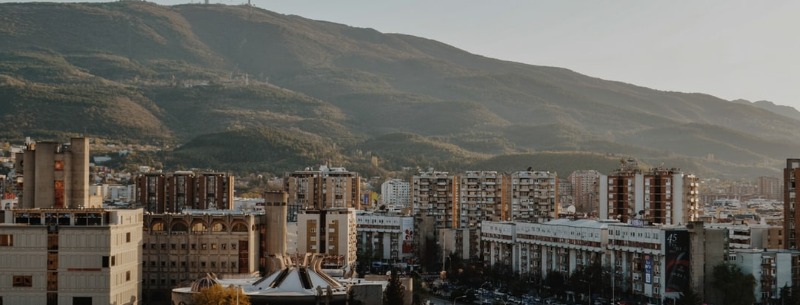Skopje, capital city of Macedonia
Skopje is the epitome of an Eastern European city. The skyline is largely made by housing blocks from the Communist era, the city’s palette is mostly grey and the public buildings are imposing behemoths. At the same time, the capital of Macedonia defies many stereotypes about cities in the region. Once you scratch the surface, you will discover copper-domed historic buildings, delicate minarets, cobbled lanes and buzzing cafes filled with stylish patrons. The capital appeals to many tastes. Foodies will love the intimate atmospheric eateries, history buffs and art lovers will rejoice in the many museums, and the fashion-conscious crowd will enjoy the chic boutiques in the trendiest neighborhoods. All visitors will quickly fall for the city’s cultural richness and friendly people.
Many different peoples have occupied the city since its foundation. Each group left a mark on Skopje, making it one of the world’s most architecturally diverse cities. On just a short walk, you may pass Byzantine churches, Roman aqueducts and Ottoman mosques in addition to modern buildings.
Although many groups have had a strong influence on the city, the Ottoman legacy is most visible today. Skopje is riddled with Ottoman caravanserais, roadside inns that provided rest and relaxation to travelers tired after the day’s journey. The network of caravanserais across Macedonia supported the flow of people, commerce and information along the region’s trade routes, and today, many are open to the public. The largest remaining caravanserai is the Kurshumli Han, also known as the “Lead Inn.” Built in 1550, the beautiful structure is made of stone and contains a courtyard surrounded by eye-catching arches and centered by a water fountain. Next door are the remains of the amam that was largely destroyed in the fire of 1689.
The Kurshumli Han is now part of the National Museum of Macedonia, a wonderful place to spend an afternoon learning about the country’s history, ethnography and archaeology. In the ethnographic section, a huge selection of national costumes helps visitors imagine traditional life. The archeological galleries have a treasure trove of artifacts from the Neolithic era through the 7th century, and the history section highlights the country’s best frescoes.
The Museum of the Macedonian Struggle opened in 2011 and pays tribute to the fight for Macedonian statehood. Visitors gain a clear understanding of the struggle through the 13 detailed exhibits and cannot help feeling a surge of pride at the end when they see the original 1991 Declaration of Independence.
Very close by is the Stone Bridge, a symbol of the city transformed by nearly every ruler. The Byzantine emperor Justinian laid the first stones in the 6th century, but it has gone through many reincarnations since then and is even being restored by the current mayor. Like the rest of Skopje, it is constantly evolving while connecting the new and the old.
The Stone Bridge is the main connection to Macedonia Square, where a marker highlights the place where Mother Teresa once lived. The Roman Catholic nun was born in the home and spent her childhood there before leaving for Ireland and later India. The square is also home to a number of statues celebrating Macedonia’s revolutionary heroes, including Goce Delcev Dame Gruev, but the most impressive is the 26-meter-tall effigy of Alexander the Great.
Other sights to explore in Skopje include the Feudal Tower, the modernistic Parliament Building, the beautiful Croatian-designed City Hospital, the Bedesten old bazaar, the Clock Tower, the imposing Kale Fortress and St. Savior Church, where some of the country’s greatest heroes are buried.
Skopje Geographical Location
Skopje is located in the central north of Macedonia on the Vardar River. It is the largest city in Macedonia and has a population of approximately 670,000.
Skopje Language
Macedonian and Albanian are the official languages of Macedonia but Macedonian is the most common.
Skopje Predominant Religion
- 65% Macedonian Orthodox
- 33% Muslim
- 2% Other
There is a tiny population of Jews in Macedonia of which live mostly in Skopje.
Skopje Currency
The Macedonian Denar is the official currency of Macedonia.
Skopje Climate
The summers in Skopje are hot and humid while the winters are cold and often snowy. Temperatures are most pleasant in the spring and autumn.
Skopje Main Attractions
- Old Bazaar
- The Stone Bridge
- Matka Lake
Other Attraction in Skopje
- Millennium Cross
- Kate Fortress
- Pantelelmon
- Sveti Kliment Ohridski
